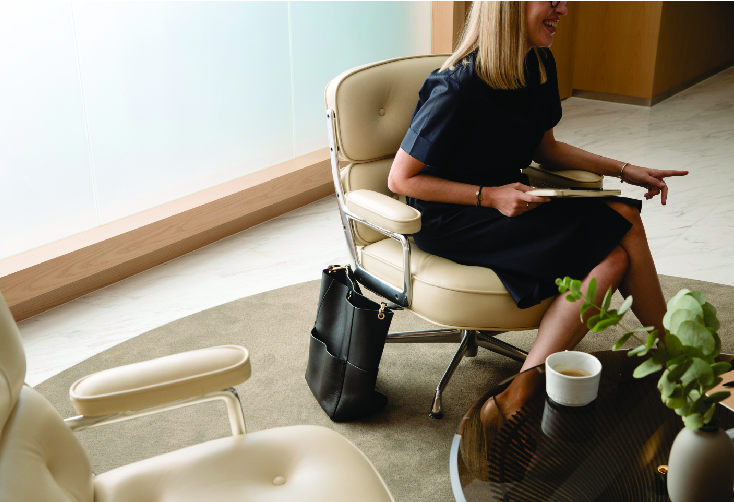The Executive Centre (TEC) recently went through what they call “a serviced office facelift”, re-examining and re-envisioning their core services and brand image.
Allwork.Space spoke with Paul Salnikow, Chairman and CEO of TEC to learn more about TEC’s transformation, from their logo and their communications to their centres’ design and their core mission. We also discussed the APAC flexible workspace market and the key differences Salnikow observes between European and US workspace members, and those in Asia Pacific.
Allwork.Space: What does it mean to give TEC a ‘facelift’?
Paul Salnikow: We are giving The Executive Centre brand a refresh. With this refresh came a re-examination of our products and services, what they stand for, what value they really add, and how they are different from what other operators in the region have to offer.
TEC has always been progressive in terms of design, with each of our centres always designed with the current corporate culture and design trends in mind. We don’t have a fitout guide for every new centre we build, we have no fixed playbook we adhere to. We build our centres with each neighborhood and market in mind, we take feedback, and we evolve and adapt accordingly.

However, the same could not be said about The Executive Centre brand. The brand has been successfully around for 25 years, and even with the changing dynamics of the market the brand remained unchanged for so long. And while this proved the brand’s strength, we also realized that we needed to change our outward communications and the way we present ourselves.
We didn’t want to just make an immediate switch. We wanted to go about it the right way; we needed to move into a transition phase. For us it was very important to be able to include TEC in our nomenclature; many of our markets and clientele refer to us as TEC even though at first introduction we are The Executive Centre. We needed to better align our brand with the market and clientele. Switching from The Executive Centre to TEC was a solid first step.
How long did the re-branding process last? What role did TEC members play in the process?
This brand rediscovery began over a year ago with the desire to help our members access and utilise our products and services more efficiently on mobile. What began with the development of the TEC app led to a redesign of the brand website, which ultimately ended in a complete re-envisioning of The Executive Centre’s core values.
So, essentially, this process began in November 2015 and still is a work in progress. TEC members played a huge role in this process: from participating in beta test sessions for different phases of our app development, to completing member surveys to help us shape our strategy.
In fact, one of the main shifts for TEC has been to refocus our energy and messaging inward, to our members, in order to truly understand what they value and what will make their experience within our centres better. This has also helped us in developing new programs and communication strategies that address our members’ needs in a more efficient and proactive manner.
What are some key aspects that TEC focused on during the re-branding process?
There were several different integral pieces that we examined during this rebrand process. The first was, what does The Executive Centre really stand for? In the past, our mission focused on our premium centres, our service, and our infrastructure; but we realized that this was self-serving and didn’t encompass what is really at the core of TEC: its members. Not only was this not at the centre of our mission, but it also wasn’t being accurately represented in all of our branded collateral.

So we recreated our mission and vision statements to reflect our ‘members-first’ ethos. The next step was to decide how we wanted to embody the new mission, both in our communication strategy and also in the infrastructure we create moving forward. Instead of speaking about the functional elements of TEC, we’ve changed our approach to be member-centric: highlighting their successes, focusing on their needs, and the types of content that will add value to their lives. The functional elements of the business act as a solid foundation, but the core of our focus now is our community and how we, as an organization, can facilitate connections between the 17K+ members that are a part of all our centres.
From a visual communication perspective, we’ve completely recreated how we represent ourselves. From the modernization of our brand logo to moving from static depersonalized depictions of our centres. We now incorporate people, stylized and dynamic visuals, and a uniform color palate across all our channels and centres. We want to position ourselves as an aspirational brand and help both current and potential members envision what it’s like to be a part of the TEC community.
Let’s talk a bit about the serviced workspace industry in the region. What are some key trends defining the industry in APAC?
The serviced workspace industry is alive and well in APAC; moreso now than ever before. With changing expectations and less stability in the market in general, organizations are leaning on serviced offices to provide support without commitment. In addition to this, the growth of coworking has increased awareness of the benefits of using flexible workspaces.
As with every trend, however, at the moment there is a vast oversupply of coworking space. While this over-abundance indicates there is interest in what we offer, the downside is that it’s challenging revenue streams. Coworking operators are offering severe discounts just to ensure tenancy, which has resulted in a marketplace price war and has negatively impacted consumer loyalty.
What differentiates the APAC serviced workspace market from Europe or America?
In APAC there is a larger number of multinational corporations that are taking up larger amounts of space in serviced workspaces because they view these markets as “foreign markets.” They are more cautious and are seeking the flexibility that allows them to hedge their exposure to the cost of leasing offices, whereas back in the USA and Europe the serviced office occupiers are in large part SMEs because the corporates take their own space with landlords. These organizations are often exploring APAC for the first time and so don’t want to invest in a full-service team, instead sending over project teams and taking advantage of the infrastructure and support provided by serviced workspaces.
Within the APAC region, India, and the Middle East, what are some key differences that TEC has had to address when opening its centres, considering your re-branding?
In Asia each city is like its own ecosystem – different business approaches, different cultural norms, different reporting and taxation regulations, even different languages. This means that you have to be adaptable – it’s not a one size fits all solution. TEC succeeds by being culturally aligned with every country. We are not a foreign company that enters into a new market and imposes our view of the world into these Asian countries, rather we localize. We have a local perspective, we respect the individuality of each city we are present in, and adapt our communications and business style to fit those expectations.
From centre design, to interior design, to our marketing material and even our sales style, we act as a local entity and this is hugely important as it first establishes us as a credible brand that understands its market and is able to adapt, and second it shows respect to where we are. We are very selective about where we expand, and if there are barriers we don’t think we can overcome, we don’t try to force fit because the ability to seamlessly integrate into the local culture is hugely important to us.


 Dr. Gleb Tsipursky – The Office Whisperer
Dr. Gleb Tsipursky – The Office Whisperer Nirit Cohen – WorkFutures
Nirit Cohen – WorkFutures Angela Howard – Culture Expert
Angela Howard – Culture Expert Drew Jones – Design & Innovation
Drew Jones – Design & Innovation Jonathan Price – CRE & Flex Expert
Jonathan Price – CRE & Flex Expert













